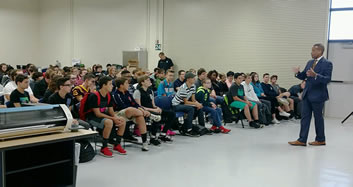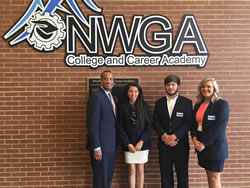Highlight Story: Sustainable Economic Growth Begins with a Skilled Workforce
November 2016 Newsletter

An employer-aligned, demand-driven comprehensive approach to skills development is essential to helping businesses across all sectors better access skilled workers in order to grow, innovate, and increase their productivity.
In recognition of this need, EDA and other federal agencies, including the U.S Departments of Labor and Education, are partnering to focus on the development of workforce training programs.
Under the Commerce Department’s Skills for Business initiative, EDA has incorporated job-driven training principles into our Comprehensive Economic Development Strategy (CEDS) (PDF guidelines to help focus communities on addressing their local and regional workforce needs. EDA’s approach to aligning economic and workforce development results in grant investments that meet the specific needs of the business community.
In the past year, EDA has invested millions of dollars to support workforce training programs and help develop high-skilled regional workforces. EDA is also working with local leaders to address and anticipate market demands for talent.

EDA Assistant Secretary Jay Williams with manufacturing students from NWGA College and Career Academy in Dalton, Georgia.
EDA’s support for workforce development is diverse and includes funding for physical infrastructure improvements (e.g., public buildings, roads, water/sewer systems, broadband) needed to construct skill-training facilities, planning and technical assistance funding to develop and implement workforce development strategies, and workforce analysis that provide critical decision-making assistance to local leaders.
Making investments in our workforce and building out critical business infrastructure are key elements of any strategy to ensure our nations’ future economic growth. When these investments are matched locally and amplify existing local and regional technological assets and expertise, they are more effective.
A few recent workforce development grants include:
- North Idaho College received $1.4 million to purchase equipment needed to support Automotive Technology and Collision, Welding Technology, and Computer Aided Design workforce training programs that will be housed in the college’s Career and Technical Education facility that is being built in Rathdrum, Idaho.
- Horry-Georgetown Technical College in Conway S.C., received a $2 million grant to will help construct a building dedicated to advanced manufacturing training.
- The Coalfield Development Corporationin Wayne, W.Va., received a $1.8 million grant to facilitate diversified workforce training and allow for existing programs to expand into larger spaces.
- Ozarks Technical Community College in Springfield, Mo. received a $1 million grant to expand its Diesel Mechanics Training Center to provide diesel automotive training to more students and local workers.
- Eastern Wyoming Community College in Torrington, Wyoming, received a $1.5 million grant to help build the Agricultural Technology Education Center, which will provide customized trainings and degrees for students in the agriculture business sector.


